Aed4life.ca
About Allerject®
Introducing Allerject® Allerject® is indicated for the emergency treatment of serious allergic reactions (anaphylaxis) and is intended for people who are at risk and for people with a history of serious allergic reactions (anaphylaxis). Allerject® should be used immediately to treat yourself or your child when experiencing a severe allergic reaction. This is emergency treatment. It does not replace seeing a doctor or going to the hospital. After injection, seek immediate medical attention. Allerject® contains epinephrine, which is the medication used for the treatment of anaphylaxis. Some of the ways it works include: • Relaxes the muscles in your airways so you can breathe
• Helps to reverse the rapid and dangerous decrease in
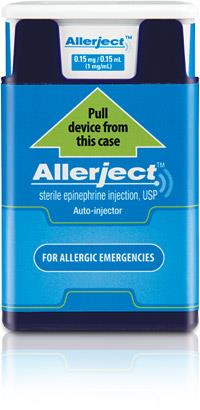
Categories Close • Major features of Allerject
® Storing and handling Allerject® Side
effects and what to do about them Using Allerject
® Warnings and precautions Dosage strengths When it
should not be used Interactions
Major features of Allerject® • Allerject® talks • Allerject® is compact • Allerject® is designed for ease of use
Allerject® talks Research shows that many patients do not know how to correctly use their auto-injector. In studies, only a modest proportion of patients (30–44%) who had been prescribed auto-injectors were able to demonstrate correct self-administration. Allerject® has been designed to address these concerns. It is the only epinephrine auto-injector with voice instructions. It guides patients and caregivers step-by-step, calmly and efficiently, through the injection process. Allerject® is available with voice instructions in either English or French. Allerject® is compact An alarming number of patients fail to carry their auto-injectors. According to research, between 30% and 70% of
patients who had been prescribed auto-injectors did not carry them at all times. One of the reasons for this non-compliance is the shape and size of existing devices. Research notes that currently available adrenaline auto-injectors are rather bulky, and their large size may hinder the ability of patients to carry the device at all times. Allerject® fits comfortably in a pocket or small purse. It has been designed to make it more convenient for patients to carry their auto-injector at all times.
Allerject® is designed for ease of use Allerject® has a number of other features designed to make it easy to use. • A light signals when the injection is complete. • A retractable needle system. Patients never see the needle
– before, during or after injection.
• A press-and-hold injection method. • The automated voice counts down the five seconds of
injection time ("5-4-3-2-1, injection complete"), helping patients maintain steady application and confirming drug delivery.
The injector has been designed to be easy-to-use, portable and ergonomic in order to assist patients with complying with recommendations that epinephrine should be available at all times and administered without delay in an allergic emergency. regular updates on our special offers as well as practical information on severe Using Allerject® • BEFORE using Allerject® • How to use Allerject® • AFTER using Allerject® BEFORE using Allerject® • Practice with the Allerject® trainer first. • Always carry Allerject® with you because you cannot
predict when a life-threatening allergic reaction may occur.
• Tell others where you keep your auto-injector in case you
are unable to speak in an allergic emergency.
• Examine the auto-injector often. The medicine in the
viewing window of the auto-injector should be clear and colourless. If the medicine looks cloudy, discoloured, or contains particles, or the expiration date has passed, Allerject® should be replaced.
• Always keep Allerject® at room temperature and away
from direct light. Direct light and extreme temperatures including excessive heat or cold can damage the medicine.
• Depending on the severity of reaction, you may require an
additional dose of epinephrine.
How to use Allerject® Allerject® contains an electronic voice instruction system to help guide you through each step of your injection. If the voice instructions do not work for any reason, use Allerject® as instructed in these Instructions for Use. It will still work during an allergic reaction emergency. Pull Allerject® from the outer case

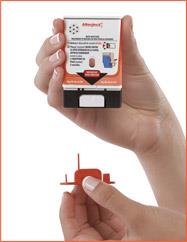
Do not go to step 2 until you are ready to use Allerject®. If you are not ready to use, put it back in the outer case. Pull off RED safety guard
To reduce the chance of an accidental injection, do not touch the black base of the auto-injector, which is where the needle comes out. If an accidental injection happens, get medical help immediately.
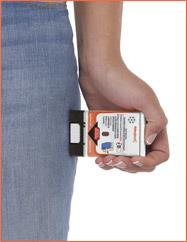

NOTE: The safety guard is meant to be tight. Pull firmly to remove.
Place BLACK end against the middle of the
outer thigh (through clothing, if necessary),
then press firmly and hold in place for five
seconds.
Only inject into the middle of the outer thigh (upper leg). Do not inject into any other location. Note: Allerject® makes a distinct sound (click and hiss) when you press it against your leg. This is normal and indicates Allerject® is working correctly. Seek immediate medical or hospital care.
Replace the outer case and take your used Allerject® with you to your pharmacist or physician for proper disposal and
replacement. AFTER using Allerject® With an allergic reaction, you may need to administer an additional dose of epinephrine. Seek medical attention immediately even if the symptoms seem to have subsided. Because the effects of epinephrine can wear off and there is a chance of a second reaction, it is important that you seek medical assistance or go to the emergency room immediately after using Allerject®. Even if you have sought medical help, you must stay within close proximity to a hospital or where you can easily call 911 for the next 48 hours. Following administration of Allerject®: • The black base will lock into place. • The voice instruction system will say Allerject® has been
used and the lights will blink red.
• The RED safety guard cannot be replaced. • The viewing window will no longer be clear. • Some medicine will remain in Allerject®. However, the
injection is complete and you have received the correct dose of the medication.
• Take to your doctor or pharmacist for proper disposal
(never discard Allerject® in regular trash).
• Discuss your medical history and current medications
with the healthcare professional (for example, diabetic patients may need to adjust the dose of their diabetes medicines or insulin after using Allerject®).
• Replace your used Allerject®. You will now need a new Allerject®. The used device and any remaining medicine cannot be reused. Until you
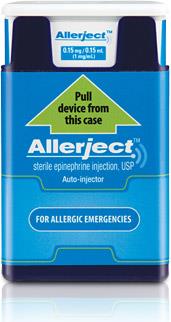
dispose of your used Allerject®, the electronic voice instruction system will remind you that it has been used when you remove the outer case. Dosage strengths Each Allerject® contains a single dose of epinephrine and is for single patient use only. There are two different dosage strengths. Selection of the appropriate dosage strength is determined according to patient body weight. Your doctor or your pharmacist will recommend the correct dose for you:
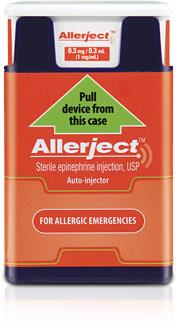
Allerject® 0.15 mg
Delivers 0.15 mg epinephrine injection and is intended for patients who
weigh 15 to 30 kg (33-66 pounds).
Allerject® 0.3mg
Delivers 0.3mg epinephrine injection and is intended for patients who weigh
30 kg (66 pounds) or more.
Allerject® is not indicated for treating children weighing less than 15 kg (33 pounds). For children under 15 kg (33 pounds), talk to your doctor about using other forms of injectable epinephrine.
Storing and handling Allerject® • Keep Allerject® at room temperature. Do not refrigerate. • Do not expose to direct sunlight. • Do not store in a vehicle during extremely hot or cold
• Do not drop. • Keep it in the outer case until you need it. • Occasionally inspect the solution through the viewing
window. The solution should be clear. Replace Allerject® if the solution is discoloured, contains particles, or there are any signs of leakage.
• Replace if damaged. • Do not tamper with or dismantle the product. • Replace before the expiry date or after use.for
the free expiry reminder service.
• Talk to your pharmacist or physician about proper
When to use Allerject® If you are having a severe allergic reaction, use Allerject® right away and then seek immediate medical attention. If your symptoms persist, another dose may be required. That's why you should always carry a second Allerject®. Anaphylaxis can result in death if not treated immediately.

Talk to your doctor about the warning signs and symptoms of anaphylaxis and when to use Allerject®. Allerject® trainers
The Allerject® trainer does not contain a needle or drug. You should use it to practice before an allergic emergency occurs to support safe and confident use of the actual Allerject® auto-injector. Trainers are easily distinguishable from the real device. They are clearly marked "Trainer" and are grey in colour. Allerject® trainers are available with voice instructions in either English or French. If you'd like to order a FREE trainer When it should not be used There are no absolute reasons for not using Allerject® in a life-threatening allergic reaction. However, it is important to tell your doctor or pharmacist about any medical
conditions and medications you take prior to using Allerject®. Side effects and what to do about them Patients with certain medical conditions, or who take certain medications, may get more or longer lasting side effects with Allerject®. This includes patients who take certain types of medicines for asthma, allergies, depression, hyperthyroidism, high blood pressure, and heart disease. • Patients with heart disease may feel chest pain (angina). • Patients with mental disease or Parkinson's disease may
have worsening symptoms of their illness.
• Too much epinephrine (Allerject®) can cause dangerously
high blood pressure, stroke, or death.
Other potential side effects include: • Paleness • Shaking • Throbbing • Restlessness • Anxiety • Tenseness • Fear Allerject® (epinephrine) can also cause the following serious side effects (most of them usually decrease with rest): • Difficulty breathing; • Increased heart rate; • Irregular or skipped heartbeats; • Chest pain (angina) or
• Stroke symptoms (blurred vision, difficulty speaking,
headache, dizziness, weakness).
Seek medical attention in all cases. This is not a complete list of side effects. For any unexpected effects while taking Allerject® contact your doctor or pharmacist. Warnings and precautions BEFORE you obtain Allerject®, talk to your doctor or pharmacist about all of your medical conditions, especially if you: • Have heart disease, irregular heartbeat, or high blood
• Have diabetes • Have thyroid conditions • Have narrow-angle glaucoma • Have depression or other mental disease • Have Parkinson's disease • Have asthma • Have previously had an allergic reaction • Are pregnant or breast feeding • Have any allergies to this drug, its ingredients or
components of the container (See "When it should not be used" section)
Allerject® remains the essential treatment for anaphylaxis even if you have the above conditions. Interactions Tell your doctor or pharmacist about every medicine you
take, including prescription and non-prescription medicines, vitamins and herbal supplements. Some medicines, especially those for asthma, may cause serious side effects if taken while using Allerject®. Some medicines may affect how Allerject® works or Allerject® may affect how other medicines work. Medications that may interact with Allerject® include: • Heart rhythm medicines, such as digoxin or quinidine
(another name for digoxin is digitalis)
• Diuretic medicines ("water pills") • MAO inhibitors (MAOI), such as selegilline,
isocarboxazid, phenelzine sulfate, or tranylcypromine
• Tricyclic antidepressants, such as amitriptyline, doxepin,
• Antihistamines, such as chlorpheniramine,
tripelennamine, or diphenhydramine
• Beta-adrenergic blocking drugs (beta blockers), such as
• Alpha-adrenergic blocking drugs (alpha blockers), such as
• Ergot alkaloids and phenothiazines • Bronchodilators used for asthma, such as isoproterenol,
orciprenaline, salbutamol and long-acting beta agonists (LABAs)
• Thyroid medications (e.g. sodium levothyroxine) Cocaine _
FAQ Question 1 Can Allerject® be used in children under 15 kg (33 pounds)? Similar to other currently available epinephrine auto-injectors, Allerject® is not indicated for treating children weighing less than 15 kg (33 pounds). For children under 15 kg (33 pounds), talk to your doctor about using other forms of injectable epinephrine. Question 2 Can a child self-administer Allerject®, or is it recommended that an adult administer the treatment? Caregivers should discuss with their healthcare professional when it's appropriate for their child to use Allerject® themselves. Question 3 Are trainers available? You can order a free trainLimited time offer while supplies last. Question 4 What are the Allerject® trainers designed to do? The trainers are designed to familiarize the patients and caregivers on how to use Allerject® in an allergic emergency. Although the trainer does not contain a needle or medicine, it functions the same way as the real device. It can be used over and over again to practice
injections. Trainers are easily distinguishable from the real device. They are clearly marked "Trainer" and are grey in colour. Allerject® trainers are available with voice instructions in either English or French. Question 5 Does Sanofi Canada provide patient information and education? Yes, Sanofi Canada works with physicians and patient support groups to provide training and education. Sanofi has developedand this website for these purposes. It also provides In addition, each device is equipped with voice-guided instructions, which guide caregivers and patients through the injection process in an anaphylactic emergency. Question 6 Should patients carry an epinephrine auto-injector if they have just a mild allergic reaction? Although first-time exposure to an allergen may only produce a mild reaction, repeated exposures may result in a more serious reaction (anaphylaxis). Owing to the unpredictable nature of anaphylaxis and accidental exposure to allergens (such as peanuts and shellfish), patients should be prescribed intramuscular adrenaline auto-injectors and carry these with them at all times. It is important that caregivers and patients speak with their healthcare provider to understand what treatment is most appropriate for their needs. Question 7 Is Allerject® still usable after the expiry date? We do not recommend that you use Allerject® after its expiry date.
to register for our expiry reminder service. Once notified, replace the product with a new Allerject®. Question 8 How do you dispose of Allerject®? If your Allerject® has expired, take it to your doctor or pharmacist for proper disposal (never discard it in regular trash). Question 9 How do patients and caregivers know that the injection has been completed? The automated voice counts down the five seconds of drug delivery time, and then informs the patient that "the injection is complete." Also, Allerject® is the only epinephrine auto-injector that has an LED light which signals when the injection is complete. A third indicator is the viewing window which will no longer be clear following injection. Question 10 Can Allerject® be injected through clothing? Yes. If necessary, you can inject Allerject® through clothing. Question 11 What should patients or caregivers do in the event of an accidental injection into hands or feet, etc? Allerject® should be injected only into the middle of the outer thigh. If it is injected into any other part of the body, seek immediate medical treatment. Do not inject Allerject® in the buttock or a vein. Question 12
If the solution seen in the viewing window is discoloured or contains particles, what should you do? Replace the Allerject® device. Discolouration indicates that the drug has been compromised (over-exposed to sunlight or extreme temperatures, for example) and should no longer be used. Question 13 Can Allerject® be purchased without a prescription? Yes, Allerject® can be purchased with or without a prescription. Prescriptions may be required for insurance reimbursement. Question 14 Who can consumers call if they have a concern or a complaint, or want more information? Contact Sanofi Canada at 855-405-4321. Please note this contact is NOT for emergency purposes. If you have an emergency situation, call 911 or go to the nearest hospital emergency room. Tips
Receiving guests with allergies – Myths and Facts Because having guests for dinner should always be fun. You enjoy the conversations, the smiles and the warm rapport between dinner guests. However, when allergies are part of the scenario, you sometimes find the situation a little uneasy to manage. No need to worry! We are here and happy to help demystify certain popular beliefs and give you a few useful tips on how to deal with food allergies as a host. The key to success is good planning!
To reduce the stress caused by the preparation of a meal for your guests with allergies, the following major principles will help you to carefully and safely plan your meal: • Know your guests allergens • Plan all your purchases accordingly • Avoid cross-contamination by safely planning every step
of your meal preparation
Cross-contamination occurs when allergenic foods or ingredients come into contact with other foods or ingredients, e.g. when a knife used to spread peanut butter is dipped into a jar of jam. Even if the knife is wiped before being dipped into the jam, the sole contact of the knife with the jam will be enough to contaminate the whole jar, and eventually trigger a reaction in a person with a peanut allergy. Keep in mind that a minute amount of allergen is enough to trigger a severe and harmful allergic reaction (anaphylaxis). Remember to never take any risk with allergies. Before meal preparation
Ask your guests to give you the list of their allergies and allergens. It may also be useful to ask them for brand names of the products they usually use. Then, plan your meals accordingly. However, if it is impossible to avoid using these allergens in certain foods, then make sure to prepare first the meals of your allergic guests and to store them in airtight containers until you are ready to serve. Avoid using bulk foods, and commercial coffee grinders that may have been used to grind hazelnut coffee as they facilitate accidental contamination. Ask for the ingredient lists of all ready-made dishes, sauces and pastries you buy. Keep all product packaging to show them to guests who wish to see their ingredient lists. During meal preparation
Always check the ingredients list of all foods you use. Avoid any food whose packaging indicates "may contain" or "traces of" because, as you know, even a minute amount of allergen can instantly trigger a severe allergic reaction. It is crucial to always thoroughly wash your hands and all kitchen utensils you intend to use with warm water and soap. Important warning: A scientific study published in 2004 in the Journal of Allergy and Clinical Immunology revealed that alcohol-based hand sanitizers do not eliminate all traces of allergens. Before you start cooking, make sure to wash all countertops, tables and work surfaces with soap and water. The aforementioned study also showed that soap and commercial cleaning agents successfully removed peanut protein from tables, while dishwashing liquid alone did not. Use different cutting boards to prepare allergenic foods. If you must prepare food that contains your guests' allergens, reduce the risks of contamination by preparing first the meals of your allergic guests, then make sure to
cover carefully all pots and pans to avoid any potential contamination due to splattering. Then, wash again your kitchen utensils. Pay special attention to containers of ingredients, such as margarine, mayonnaise, etc., as well as to small appliances, such as the toaster or blender, as they may have been in contact with the allergens you want to avoid. Meal service Make sure to let your allergic guests know if any food on the table contains their allergens. Serve your allergic guests first to avoid any risks of cross-contamination during meal service. Myths and Facts
Food intolerance or food allergy? Because these two conditions share some of the same symptoms, people sometimes have the tendency to mix them up. A food intolerance may inconvenience a person by causing gastrointestinal discomfort (nausea, vomiting,
etc.), whereas a food allergy may often have undesirable and even fatal consequences. Food allergies trigger a reaction of the immune system that may involve several parts of the body. Remember, even a minute amount of allergen can instantly trigger a severe allergic reaction. Symptoms of a food allergy may include: rash, hives or itchy skin, shortness of breath, and chest pain. They may also include the following life-threatening symptoms: sudden drop in blood pressure, trouble swallowing and/or breathing. Call 911 immediately if your guest is experiencing one or more symptoms from the life-threatening category. Food intolerance symptoms appear gradually and do not affect the immune system. However, although these symptoms may be unpleasant, they do not trigger any potentially fatal anaphylactic reaction. Many reasons may explain food intolerance. If you repeatedly suffer from gastrointestinal discomfort after eating certain foods, talk to your healthcare professional. Can an allergic reaction be triggered simply by the smell of allergenic food? No. The reason is that food allergy is triggered by the protein of the food. The aromatic food molecules do not contain that protein, and thus cannot trigger an allergic reaction. However, particles of a food allergen that have become airborne may trigger an allergic reaction. For instance, when we cook or fry fish in a pan, fish proteins may become airborne and be absorbed through the respiratory tract of an allergic person, then trigger a severe allergic reaction. Can an allergic reaction be triggered by simply touching
allergenic food? Yes. However, skin reactions are less harmful and do not develop in all types of allergies. On the other hand, if the food allergen comes into contact with an open wound and enters the body, or if the person touches his or her mouth, then a potentially harmful systemic allergic reaction (or anaphylaxis) may occur. Can an allergic reaction be triggered by a simple kiss? Yes. An allergic reaction may occur if the allergen gets on the lips or into the mouth of the allergic person and enters the body. A scientific study conducted in 2006 showed that traces of allergens are still found in the saliva, even after we brush our teeth, rinse our mouth or chew gum. It is therefore recommended that people with food allergies wait several hours before kissing someone who has eaten an allergenic food.
In conclusion, the most important principle to remember is that severe allergies are not a fantasy! Always keep in mind that even a minute amount of allergen can instantly trigger
a severe allergic reaction. Good planning and good communications with your guests with allergies will allow you to share precious moments around the table with all your loved ones!
Source: https://aed4life.ca/pdf/Allerject/All-About-Allerject.pdf
SANTA CASA DE MISERICÓRDIA DE BELO HORIZONTE Núcleo de Pós Graduação e Pesquisa AVALIAÇÃO DA QUALIDADE DE VIDA DE PACIENTES COM HIV E AIDS ATENDIDOS NO CENTRO DE REFERÊNCIA E PROMOÇÃO DA SAÚDE DE CONSELHEIRO LAFAIETE - MG. PATRÍCIA SANCHES CARNEIRO PATRÍCIA SANCHES CARNEIRO AVALIAÇÃO DA QUALIDADE DE VIDA DE PACIENTES COM HIV E AIDS ATENDIDOS NO CENTRO DE REFERÊNCIA E PROMOÇÃO DA SAÚDE DE
UNIVERSIDAD NACIONAL EXPERIMENTAL DE GUAYANA ESPECIALIZACIÓN EN SALUD OCUPACIONAL MENCIÓN MEDICINA DEL TRABAJO PREVALENCIA DE DISFUNCIÓN ERÉCTIL EN TRABAJADORES DE TALADROS PETROLEROS ANACO EDO. ANZOATEGUI Trabajo Especial de Grado para optar a la Especialización en Salud Ocupacional mención Medicina del Trabajo. Autor: Sheila P. Blasco Aguilera Tutor: Dra. YoilrmaVaccaro Campos








